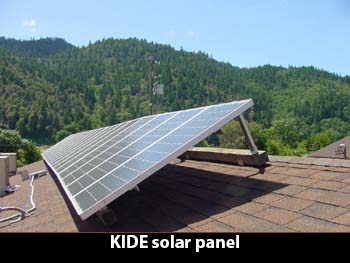By Diane Reinhardt
Community radio has always drawn its power from its environment. And so it’s no surprise that a growing number of community stations are making that commitment literal–running on the renewable energy of water, wind, and sun.
WJFF Radio Catskill: Hydropowered from the beginning
Inspired by the work of Malcolm Brown, a pioneering renewable energy advocate, and by a committed community of volunteers, New York’s WJFF Radio Catskill has been hydropowered since its establishment in February, 1990.
In 1984, Malcolm Brown bought a generating site next to Lake Jefferson, where, in the 1920’s, both the lake itself and a dam had been constructed for a hydroelectric project that was never completed. In 1986, his company, Jefferson Hydroelectric, was formed.
Today, Jefferson Hydroelectric, owned now by Kevin and Barbara Gef (WJFF volunteers), not only produces WJFF’s power but also excess power sufficient to sell to NYSEG’s commercial grid. The station’s power is weather-dependent; in times of drought or flood, the station goes back on the grid.
WJFF is located in Jeffersonville, New York, a community with a population of about 1,600. Jefferson Hydroelectric is monitored by the Federal Energy Regulatory Commission and is categorized as a micro-hydro project by the US Department of Energy. The powerhouse has a 70 killowatt capacity, power sufficient for 20 to 25 homes.
(Credit: The information for this article was taken from WJFF’s website where readers can find a more developed history of the station’s use of and commitment to hydropower.)
KRCL Community Radio: Wind and Sun
By 2009, KRCL Community Radio, broadcasting out of Salt Lake City, Utah, was already 100% wind-powered through Rocky Mountain Power’s Blue Sky program. Further, KRCL had also created a solar-powered backup system, one that is always online, reducing the station’s need for power from the commercial grid. Battery storage guarantees that the station can remain on the air for up to 12 hours in the event of a power outage.
On its website, KRCL describes itself as a volunteer, listener-supporter station, dedicated to local public affairs programming. The station reaches 70,000 listeners per week in Wyoming, Idaho and Nevada.
(Credit: Information for this article was found in Tom Vernon’s “Stations Go Green Without Seeing Red,” Radio World (August 28, 2009) and on KRCL’s website.)
KIDE Community Radio: California’s First Solar-powered Native American-owned Station
Serving a people who have lived on the same land for over 10,000 years, KIDE Community Radio is the country’s first station owned by Native American Indians. And now it is also the first solar powered radio station in California.
Located in the Hoopa Valley Indian Reservation, the station “is in the business of promoting Social Change and advocating Environmental Justice.”
(Credit: Information for this article comes from Amit Prabhu’s “Top Five American Radio Stations That Run on Clean Solar Energy,” Eco Friend (November 2, 2011 and from KIDE’s website)
KZMU Community Radio: Almost a Decade of Wind and Sun
In the spring of 2003, KZMU, located in Moab, Utah, joined Utah Power’s Blue Sky Program and became 100% wind-powered. The program allowed KZMU to purchase power from wind farms located in Oregon and Wyoming. Then, in 2008, KZMU went solar, 100%.
Benefiting from a grant from Rocky Mountain Power that covered half of the project’s cost and from the efforts of Kent Alcorn of American Solar Power, the station turned to its listeners for the remaining funding needed to purchase 60 3×5 solar panels that are arranged in arrays of 12 per pack. During the day, the system generates more power than the station uses, and the excess is put back on the grid. At night, the station draws from the grid, but the station still uses less than it consumes.
Moab, a town of about 8,000 residents, is located approximately 120 miles from the nearest city. KZMU is an all-volunteer station that produces almost all its own local programming, with the exception of its Pacifica affiliation and a few regional shows. It was founded in 1992 in an abandoned National Park Service trailer and moved to a permanent studio in 1999.
(Credit: Information for this article is taken from KZMU’s website)
Where Have We Been? Where Are We Going?
Each of these stations—and a growing number of other stations across the country– has a fundamental story to tell: renewable energy works. In future articles, we’ll trace these commitments and technologies in greater depth.
Diane Reinhardt lives in Brooklyn, New York. For thirty years, she taught English and served as a union officer at a Long Island high school. She is the principal writer for the Pacifica Affiliate Newsletter.


